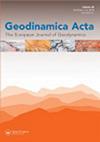中始新世至晚中新世气候条件的空间分布——基于安纳托利亚中部、东部和西部孢粉区
IF 1.5
Q1 Earth and Planetary Sciences
引用次数: 30
摘要
用共存方法定量地重建了近4500万年的安纳托利亚大陆气候演化。尽管存在一定的区域性影响,但安纳托利亚新生代大陆气候记录与欧洲气候条件和全球海洋环境氧同位素记录具有相关性。从始新世中期到中新世晚期,安纳托利亚的冬季气温和年平均气温与欧洲一样明显变暖。根据氧同位素记录,安纳托利亚的古气候特征与欧洲气候变化和海洋温度变化相似;然而,安纳托利亚陆相区域的气候值从卢泰安期到阿基坦期较高,而从阿基坦期到托尔顿期低于欧洲。相应地,安纳托利亚新生代气候变冷与季节性、古地理位置和陆相条件的增加直接相关。始新世—渐新世期间,安纳托利亚年均降水量保持相对稳定;然而,这些数值在中新世中晚期有所变化。此外,本研究还记录了近4500万年来红树林和红树林古群落的丰度和变量的下降,这主要是由于湿度、温度的降低和陆地条件的增加。本文章由计算机程序翻译,如有差异,请以英文原文为准。
Spatial distribution of climatic conditions from the Middle Eocene to Late Miocene based on palynoflora in Central, Eastern and Western Anatolia
The continental climatic evolution of Anatolia has been reconstructed quantitatively for the last 45 million years using the coexistence approach. Although there were some regional effects, the Anatolian Cenozoic continental climate record correlated with the European climatic condition and the global oxygen isotope record from marine environments. From middle Eocene to late Miocene, continental warming in Anatolia was pronounced for inferred winter temperature and mean annual temperature as in Europe. Generally, the palaeoclimatic property of Anatolia resembles the European climatic changing and marine temperature changing based on the oxygen isotope record; however, climatic values of the terrestrial area in Anatolia are higher from Lutetian to Aquitanian and these values are lower than European values from Aquitanian to Tortonian. Correspondingly, Cenozoic climatic cooling in Anatolia is directly associated with an increase of seasonality, palaeogeographic position and terrestrial condition. Furthermore, mean annual precipitation values of Anatolia remained relatively stable during the Eocene–Oligocene; however, these values indicated changing throughout middle–late Miocene. Moreover, in this study, decline of abundance and variables for the mangrove and back mangrove palaeocommunities during the last 45 million years is recorded because of the decreasing of humidity, temperature and increasing of terrestrial condition.
求助全文
通过发布文献求助,成功后即可免费获取论文全文。
去求助
来源期刊

Geodinamica Acta
地学-地球科学综合
CiteScore
4.50
自引率
0.00%
发文量
0
审稿时长
25 weeks
期刊介绍:
Geodinamica Acta provides an international and interdisciplinary forum for the publication of results of recent research dealing with both internal and external geodynamics. Its aims to promote discussion between the various disciplines that work on the dynamics of the lithosphere and hydrosphere. There are no constraints over themes, provided the main thrust of the paper relates to Earth''s internal and external geodynamics. The Journal encourages the submission of papers in all fields of earth sciences, such as biostratigraphy, geochemistry, geochronology and thermochronology, geohazards and their societal impacts, geomorphology, geophysics, glaciology, igneous and metamorphic petrology, magmatism, marine geology, metamorphism, mineral-deposits and energy resources, mineralogy, orogeny, palaeoclimatology, palaeoecology, paleoceanograpgy, palaeontology, petroleum geology, sedimentology, seismology and earthquakes, stratigraphy, structural geology, surface processes, tectonics (neoteoctonic, plate tectonics, seismo-tectonics, Active tectonics) and volcanism.
Geodinamica Acta publishes high quality, peer-reviewed original and timely scientific papers, comprehensive review articles on hot topics of current interest, rapid communications relating to a significant advance in the earth sciences with broad interest, and discussions of papers that have already appeared in recent issues of the journal. Book reviews are also included. Submitted papers must have international appeal and regional implications; they should present work that would be of interest to many different specialists. Geographic coverage is global and work on any part of the world is considered. The Journal also publishes thematic sets of papers on topical aspects of earth sciences or special issues of selected papers from conferences.
 求助内容:
求助内容: 应助结果提醒方式:
应助结果提醒方式:


